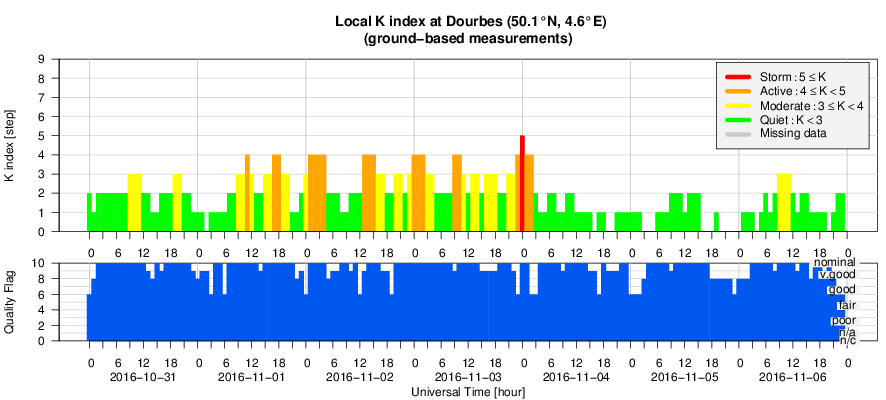- Table of Content
- 1.SC24 and the N...
- 2.It almost star...
- 3.PROBA2 Observa...
- 4.Review of sola...
- 5.The Internatio...
- 6.Review of geom...
- 7.Geomagnetic Ob...
- 8.Review of iono...
- 9.Future Events
2. It almost started: ESWW13
3. PROBA2 Observations (31 Oct 2016 - 6 Nov 2016)
4. Review of solar activity
5. The International Sunspot Number
6. Review of geomagnetic activity
7. Geomagnetic Observations at Dourbes (31 Oct 2016 - 6 Nov 2016)
8. Review of ionospheric activity (31 Oct 2016 - 6 Nov 2016)
9. Future Events
SC24 and the NOAA-scales
Once again, solar activity has been very low last week. One could wonder how poor the performance of ongoing solar cycle 24 (SC24) has been compared to the previous solar cycles. For that, one could use the famous NOAA-scales (http://www.swpc.noaa.gov/noaa-scales-explanation ) which link objective solar parameters such as the x-ray flux to all kinds of practical space weather effects such as on radio communication. More details can be found on the NOAA/SWPC webpage.
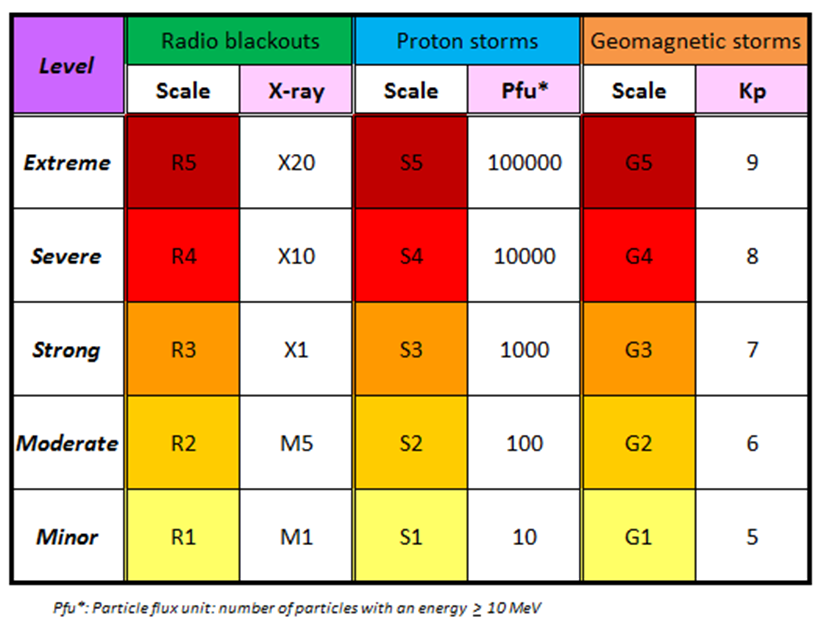
The scales describe three types of environmental disturbances: radio blackouts (R-scale), solar radiation storms (S-scale) and geomagnetic storms (G-scale). For these, three physical parameters are used, resp. solar flares (x-ray flux), proton storms (number of protons with energies greater than 10 MeV), and the Kp-index (see http://www.stce.be/news/243/welcome.html ). All scales consists of 5 levels (1 to 5), conveying the intensity of the event (minor to extreme). The table above provides a summary of scales and intensities. A few examples. An X6.9 flare would be rated as an R3 event, a proton flare with a peak flux of e.g. 350 pfu would be rated as an S2 event (between 100 and 1000 pfu), and a severe geomagnetic storm (Kp=8) as a G4 event.
Systematic satellite observations of the Sun started in 1976 with GOES. For each year and for each disturbance type, one can count for every level the number of events. E.g. so far for 2016, we've had only 10 R1 events (flares with intensity between M1 and M5) and 4 R2 events (intensity between M5 and X1). Data can be retrieved at resp. NGDC/NOAA (ftp://ftp.ngdc.noaa.gov/STP/space-weather/solar-data/ ), NASA/NOAA (http://umbra.nascom.nasa.gov/SEP/ ), and WDC Kyoto (http://wdc.kugi.kyoto-u.ac.jp/index.html ), and run through mid-October 2016.
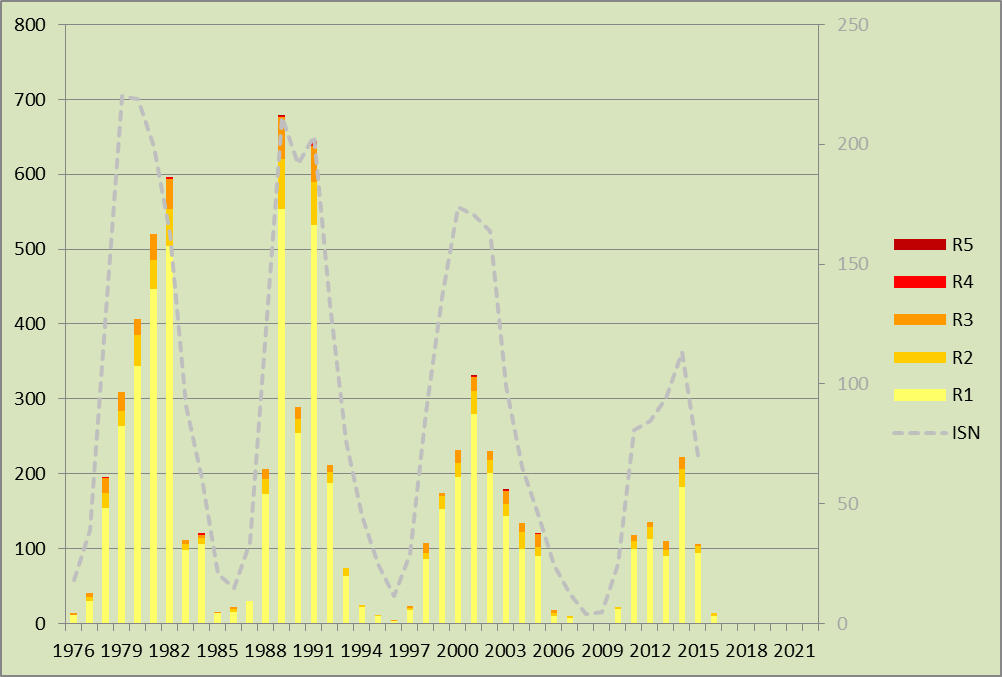
Each graph shows the yearly accumulation of the events, with the yearly International Sunspot Number (SILSO; http://www.sidc.be/silso/ ) superposed on it as the gray dashed line. E.g. in the chart above, for 2014 -the year of SC24 maximum-, the number of radio blackouts amounted to 222, consisting of 183 minor (R1), 23 moderate (R2), and 16 strong (R3) events. This is clearly less than during previous solar cycles such as e.g. in 1989 when there were no less than 679 radio blackouts including 59 strong or more intense events! Also, SC24 has not produced any severe or extreme event so far, i.e. X10 or stronger flare.
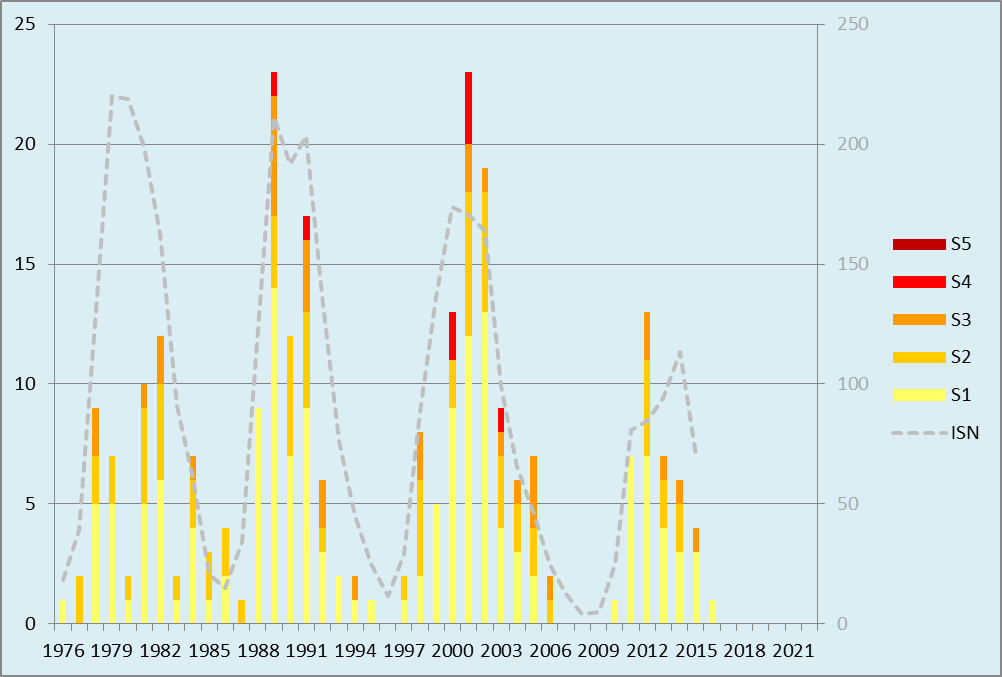
Concerning the number of solar radiation storms (proton storms), it is no surprise that SC24 is again the least active. Interestingly, it is not that much lower in number (39 vs. 59) and intensity (max. S3 events) than SC21 despite the large difference in maximum yearly sunspot number (220 vs. 113). Also remarkable is that 2012 is the year with the most and most intense radiation storms during SC24, and not 2014, the year of solar cycle maximum.
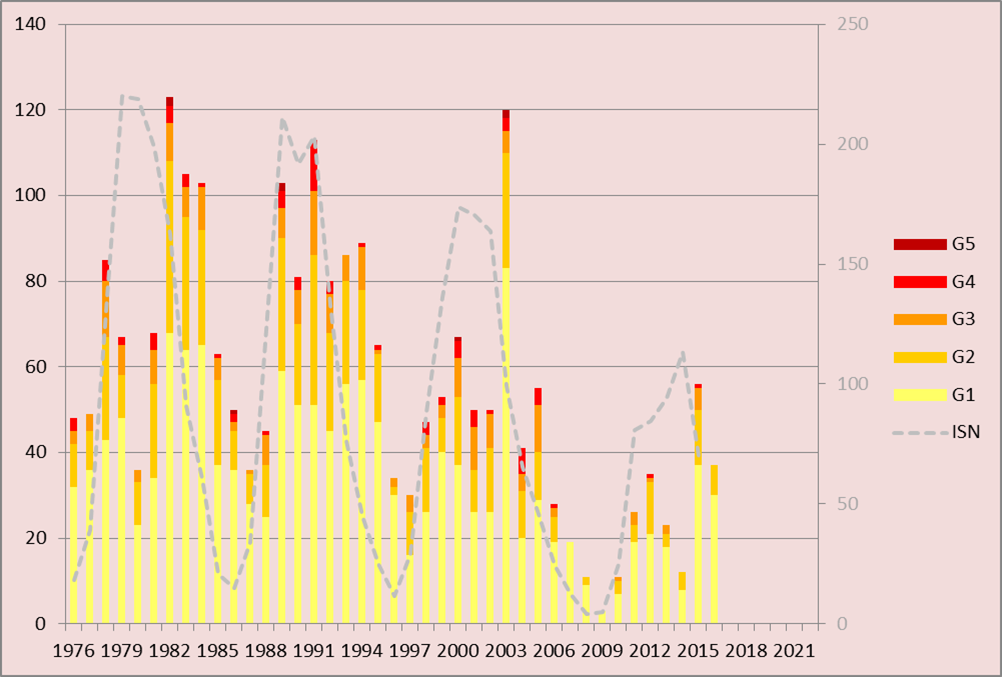
The plot of the geomagnetic storm days bears much less resemblance with the evolution of the sunspot number than in the previous two charts. This is because minor to strong geomagnetic disturbances can also be caused by the high speed solar wind streams (HSS) from coronal holes, hence distorting the familiar outlook of the sunspot cycle. Nonetheless, even then it is very clear that SC24 has been quite disappointing when it comes to the number and intensity of geomagnetic storms, with no extreme storms (G5) so far and precious few severe events (G4). Worse, the numbers even get depressingly low when one compares to other years such as e.g. the 120 storming days in 2003. Interestingly, the number of geomagnetic storm days is peaking in 2015-2016, so after the SC24 maximum in 2014. This is particularly due to the HSS from numerous coronal holes, and is a well-known aspect of this stage of a solar cycle.
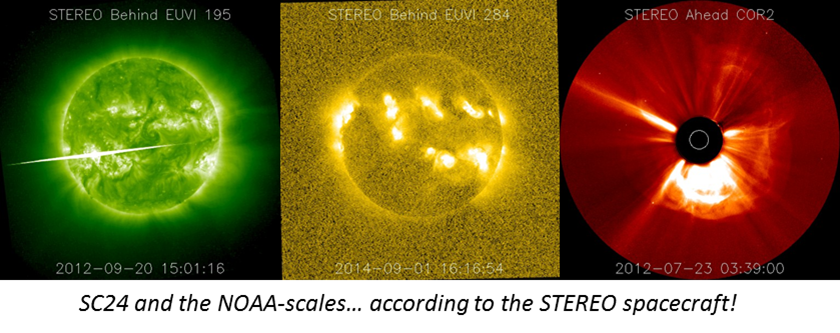
It almost started: ESWW13

The European Space Weather Week (ESWW) is the international conference par excellence when it comes to space weather. Already for the 11th time, its organisation is in the hands of the Solar-Terrestrial Centre of Excellence (STCE). Once again, hundreds of scientists, engineers, satellite operators, power grid technicians, communication specialists,... from all over the world will come to Oostende to discuss the latest on solar activity and how it influences the earth environment and our technologies.
Recent communications by the USA and the EU emphasize the importance that space weather has in space activities and infrastructure. The ESWW offers an opportunity to exchange knowledge and ideas to improve space weather services so we can prepare ourselves better when severe space weather strikes. Daily space weather bulletins will be broadcasted live by a Belgian, a Spanish, two British and an American forecast centre.
Since 2013, three prestigious space weather medals are awarded during the annual ESWW conference. One medal rewards a young researcher for major contributions to space weather research and/or services, another is for outstanding scientific or technological results, and a third is awarded for efforts to structure the space weather community at an international level. The 4th ESWW medal award ceremony will take place on Monday 14 November.
For Dutch, French: http://www.stce.be/esww13/press.php
PROBA2 Observations (31 Oct 2016 - 6 Nov 2016)
Solar Activity
Solar flare activity remained very low during the week.
In order to view the activity of this week in more detail, we suggest to go to the following website from which all the daily (normal and difference) movies can be accessed: http://proba2.oma.be/ssa
This page also lists the recorded flaring events.
A weekly overview movie can be found here (SWAP week 345).
http://proba2.oma.be/swap/data/mpg/movies/weekly_movies/weekly_movie_2016_10_31.mp4
Details about some of this week's events, can be found further below.
If any of the linked movies are unavailable they can be found in the P2SC movie repository here
http://proba2.oma.be/swap/data/mpg/movies/
Saturday Nov 05
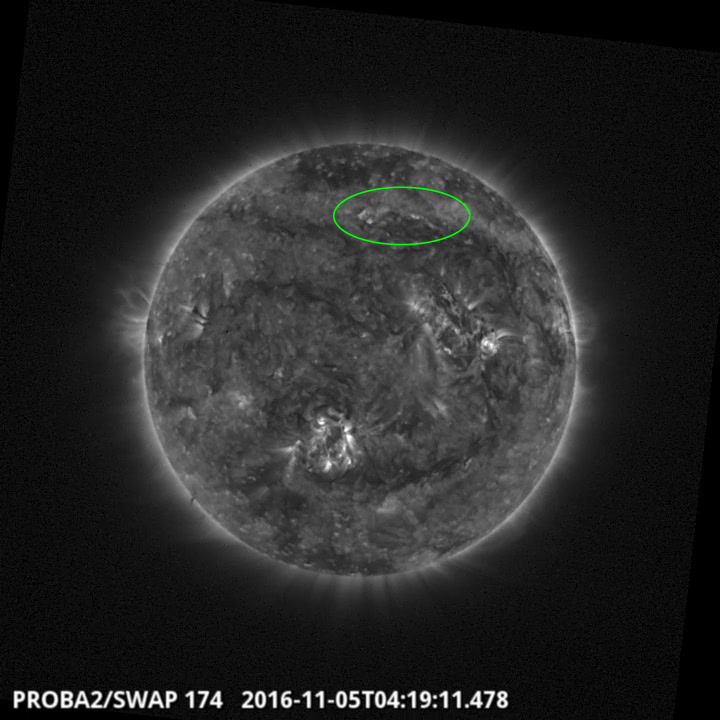
A flow and possible failed eruption was observed by SWAP in the north west quadrant of the
Sun on 2016-Nov-05 at 04:19 UT
Find a movie of the event here (SWAP movie)
http://proba2.oma.be/swap/data/mpg/movies/20161105_swap_movie.mp4
Review of solar activity
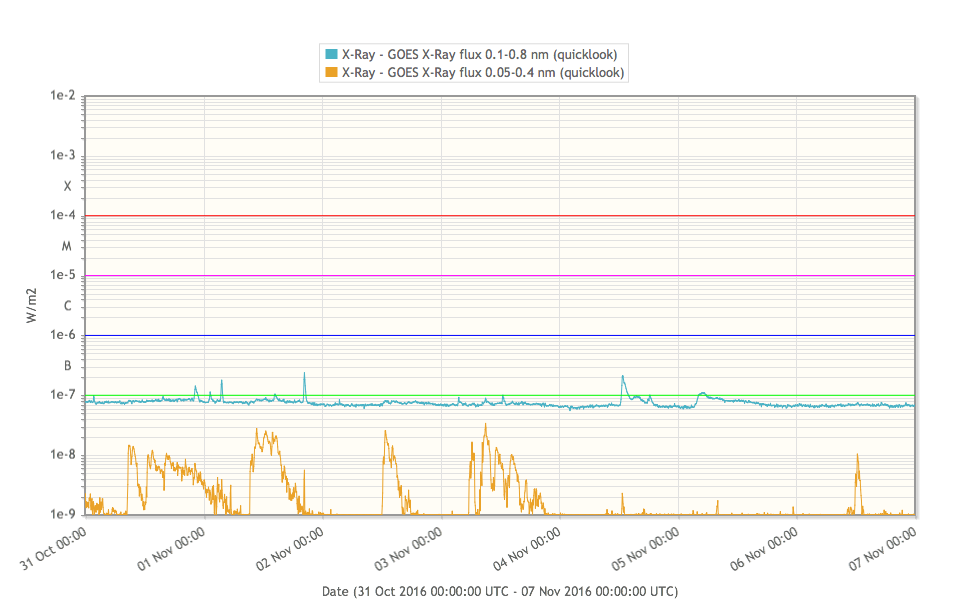
Solar flaring activity was very low and restricted to low-level B-class flares. Only two small sunspot groups were observed most of the week, with NOAA 2605 the most active region producing a B2.2 flare on 5 November.
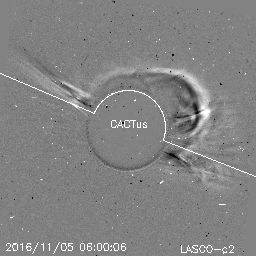
Cactus detected a slow partial halo CME early in the morning on November 5 initiated by the filament eruption in the North-Western quadrant. The ejection is mostly directed towards the North-East and has an angular extent of 220 degrees.
The International Sunspot Number
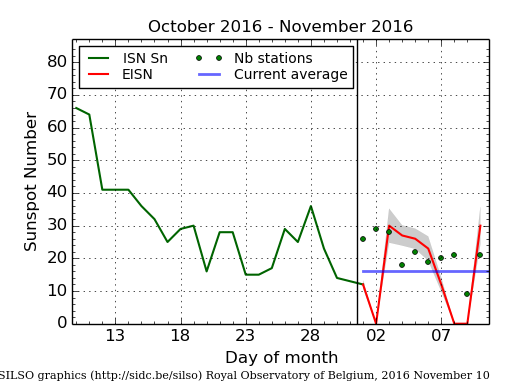
The daily Estimated International Sunspot Number (EISN, red curve with shaded error) derived by a simplified method from real-time data from the worldwide SILSO network. It extends the official Sunspot Number from the full processing of the preceding month (green line). The plot shows the last 30 days (about one solar rotation). The horizontal blue line shows the current monthly average, while the green dots give the number of stations included in the calculation of the EISN for each day.
Review of geomagnetic activity
The earth-environment started the week under the waning influence of the solar wind stream from the coronal hole, which reached nominal solar wind values only on 2 November. Solar wind speed decreased from about 550 km/s to 315 km/s by the end of the period. Bz fluctuated between +2 and -3 nT, with occasionally sustained positive intervals. Check the graphs below (STAFF viewer, http://www.staff.oma.be )
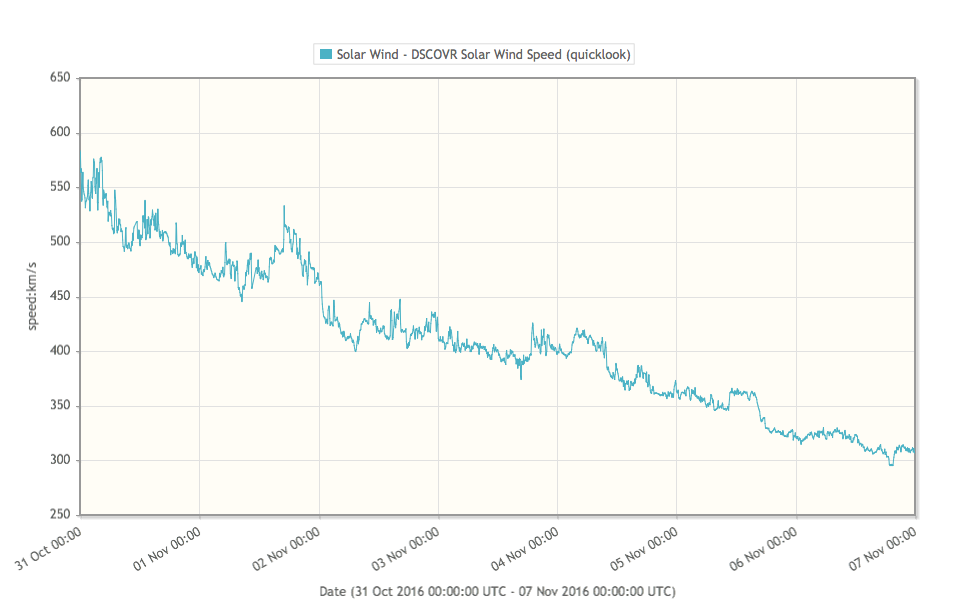
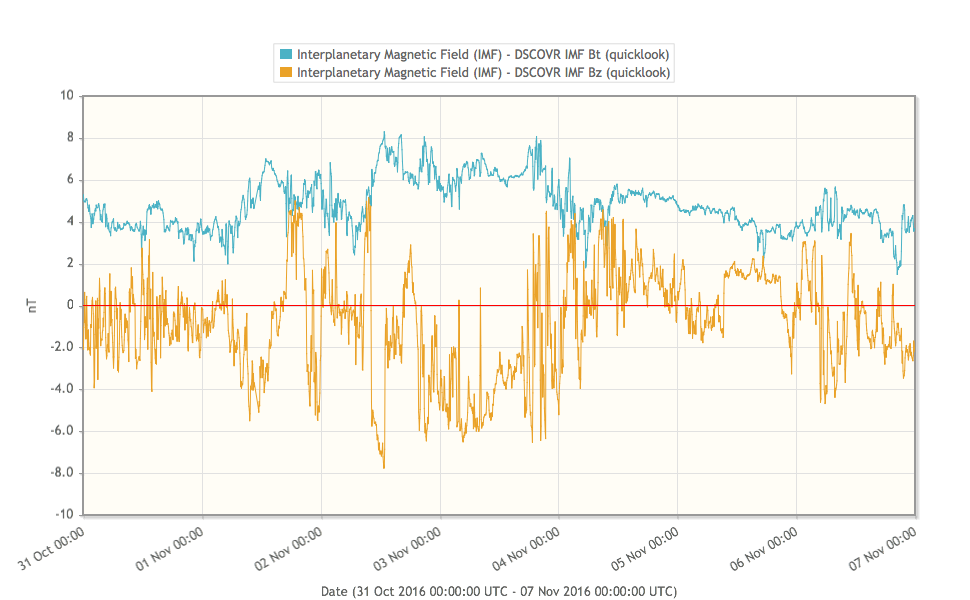
The geomagnetic conditions were quiet (K Dourbes between 0 and 4; NOAA Kp between 0 and 4). No geomagnetic storms were observed. Only once Kp index elevated till K Dourbes = 5 on November 4.
Review of ionospheric activity (31 Oct 2016 - 6 Nov 2016)
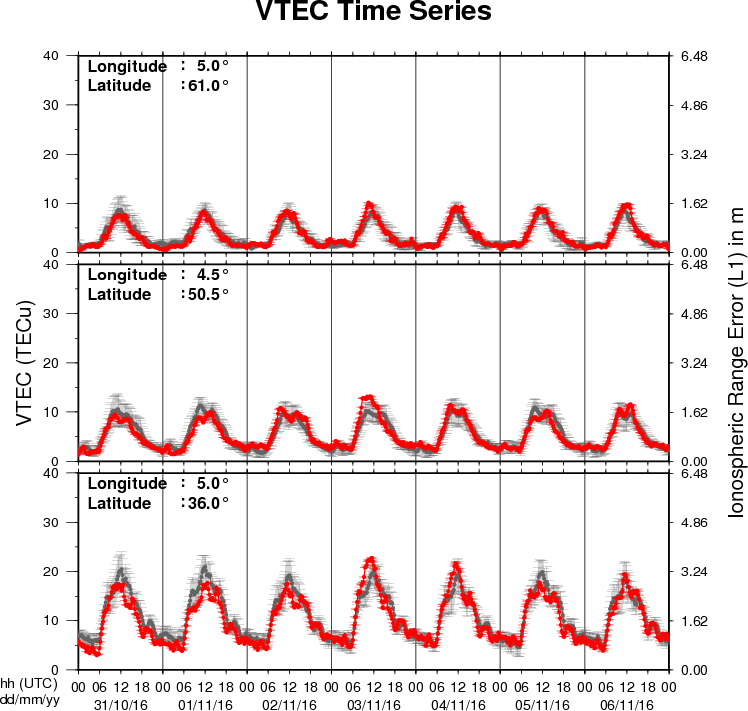
The figure shows the time evolution of the Vertical Total Electron Content (VTEC) (in red) during the last week at three locations:
a) in the northern part of Europe(N61°, 5°E)
b) above Brussels(N50.5°, 4.5°E)
c) in the southern part of Europe(N36°, 5°E)
This figure also shows (in grey) the normal ionospheric behaviour expected based on the median VTEC from the 15 previous days.
The VTEC is expressed in TECu (with TECu=10^16 electrons per square meter) and is directly related to the signal propagation delay due to the ionosphere (in figure: delay on GPS L1 frequency).
The Sun's radiation ionizes the Earth's upper atmosphere, the ionosphere, located from about 60km to 1000km above the Earth's surface.The ionization process in the ionosphere produces ions and free electrons. These electrons perturb the propagation of the GNSS (Global Navigation Satellite System) signals by inducing a so-called ionospheric delay.
See http://stce.be/newsletter/GNSS_final.pdf for some more explanations ; for detailed information, see http://gnss.be/ionosphere_tutorial.php
Future Events
For more details, see http://www.spaceweather.eu/en/event/future
European Space Weather Week in Ostend, Belgium
Start : 2016-11-14 - End : 2016-11-18
The ESWW is the main annual event in the European Space Weather
calendar. It is the European forum for Space Weather as proven by
the high attendance to the past editions. The agenda will be
composed of plenary/parallel sessions, working meetings and
dedicated events for service end-users. The ESWW will again adopt
the central aim of bringing together the diverse groups in Europe
working on different aspects of Space Weather.
Website:
http://www.stce.be/esww13/
4th SOLARNET Meeting: The Physics of the Sun from the Interior to the Outer Atmosphere, in Lanzarote (Spain)
Start : 2017-01-16 - End : 2017-01-20
The IV SOLARNET MEETING 'The physics of the Sun from the
interior to the outer atmosphere' will take place in Lanzarote
(Spain) from 16th to 20th of January 2017, organized by the
Instituto de AstrofÃsica de Canarias (IAC).
SOLARNET (High-resolution Solar Physics Network) is an EU-FP7
project coordinated by IAC with the aim of bringing together and
integrating the major European research infrastructures in the
field of high-resolution solar physics. SOLARNET involves all
pertinent European research institutions, infrastructures, and data
repositories. Networking activities, access to first-class
infrastructures and joint research and development activities are
being covered under SOLARNET to improve, in quantity and quality,
the service provided by this European community.
The purpose of this conference is to provide a coherent picture
of the Sun as a single physical system playing all the underlying
physical processes measured and observed in the solar atmosphere to
date.
Website:
http://www.iac.es/congreso/solarnet-4meeting/
Solar Orbiter Workshop 7: Exploring the solar environs in Granada, Spain
Start : 2017-04-03 - End : 2017-04-06
This event will be hosted by the Instituto de Astrofisica de
Andalucia - CSIC. Please mind that on April 7th the 20th SWT
meeting will take place at the same venue.
Website: Unkown
